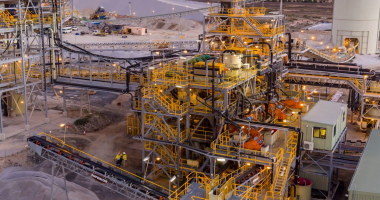When the EU Council granted final approvals to its Critical Raw Material Act back in March, it underscored the region’s desire to overcome the challenge of China dominating the supply chain for minerals essential for the green transitional and digital technology into near and medium term.
Identifying 34 critical materials together with 17 strategic ones, the Act established a framework for how these materials should be accessed in the future: with 10 percent of supply to come from local extraction, 40 percent to be processed in the EU, and 25 percent to be taken from recycled materials.
The ruling has placed a spotlight on companies who are on the hunt for these minerals within the European Union, many of whom are finding innovative ways to secure supplies quickly, through various development initiatives.
And perhaps the most watched are those seeking to pin down resources of lithium: a material central to production of electric vehicle batteries, but which is also contributing to news flow as due to China’s dominance as the main global producer, and other jurisdiction’s attempts to overcome this, even as the market is in oversupply mode.
The price of lithium dropped below the 100,000 Chinese yuan per tonne mark in December, a two-year low influenced by a continuing reality of surplus and has since then crawled around a tight range just above the line. At the same time, Beijing announced plans to double output over the next ten years, while both the EU and US have hit back with large tariffs targeting Chinese EV producers and seeking to control their own supply of lithium.
A project of regional and national significance
The EU’s second-largest hard rock lithium deposit is the one being developed by Infinity Lithium Corporation (ASX:INF) in Spain’s western Extremadura region. As a testament to its potential, Infinity’s San Jose project – which has now reached an advanced stage in its permitting process – was last week nominated as a project of regional and national significance by the Extremadura government.
On June 13, the company announced it had submitted documents for an Exploitation Concession Application (ECA) to the local government, which would enable mining in this jurisdiction. Progressing through this stage had entailed developing a project exploitation plan for mining and processing, as well as a rehabilitation and restoration plan and environmental impact assessment.
Following the government’s review of these, the application will move to a further stage, of public consultation.
“The detailed submission was prepared in anticipation of the confirmation of a viable lithium resource at San Jose and the advancement through Stage 1 of the process,” said Infinity’s general manager of Corporate Affairs Justin Samulski.
“The next 6-12 months will involve continuing to collaborate with the regional authorities and local stakeholders as we progress through the final stages of the permitting process.
“As we advance the technical aspects of the project, planning and consideration for the construction of a pilot plant has been ongoing as has the next stages of engineering with progressions towards a DFS (definitive feasibility study).”
The importance of place
Mr Samulski said that as Infinity confirms the viability of the San Jose project, the team was bolstered by the benefits of its size and location, its advanced status as a previously mined brownfields project, and as the region’s pressing demand for lithium.
“Extremadura is fortunate to host one the EU’s largest lithium deposit,” he said.
“It is an enormous resource that just happens to be in a region that is going to need a large amount of lithium chemicals in the very near future.”
In order to best approach this need, Infinity is planning to build a lithium chemicals conversion plant adjacent to the mine site.
“Given the nature of the resource it made sense to build the conversion facility on-site in order to keep transport distances and costs to a minimum, deliver a world class and sustainable project in line with European and local requirements, whilst retaining the strategic control of an end lithium chemical product that is critical for the automotive industry in Europe,” Mr Samulski said.
“This is compounded with geopolitical considerations and security of supply in localised value chains, and recent EU elections have highlighted an increasing focus within the EU on national interests.
“However, it is also a big opportunity for the local region of Extremadura as the project will bring with it large scale and long-term employment opportunities in a place which has not had such opportunities historically.”
Mr Samulski said the local government in Extremadura had already begun seeking investment in future industries such as renewable energies and electrification.
“This has been evident with their handling of permitting for Envision’s gigafactory which occurred in rapid time, the signing of an MoU with Chinese cathode maker Hunan Yuneng for the construction of a cathode factory in the capital of Extremadura, and the hosting of an international forum on electrification in which many of the world’s largest contributors were invited to see what Extremadura has to offer,” he said.
“In short, Extremadura can realise their ambitions for a lithium-ion battery value chain that is cornerstoned through the availability of lithium in Europe.
“It is clear, the region is aligning its future to developing a localised lithium-ion battery value chain.”
Adding to the EU’s critical minerals market
Mr Samulski added that as the European Union seeks to prioritise local critical minerals supplies, San José had the potential to contribute to the region’s critical minerals market and economic landscape.
“The geopolitical landscape in Europe has clearly changed over the last couple of years and the European Commission has realised it needs to take control of its own destiny to protect its industrial sovereignty,” he said.
“Given the limited number of European battery material and in particular lithium projects as it stands, and the large volumes of critical raw materials the region will require, Europe needs to get behind all of its domestic projects as it will need unattainable volumes of lithium chemicals from domestic supplies (where reasonable) to come to fruition to meet its goals.
“San José is a long life and low operating cost integrated lithium refining project that can produce approximately 33,000tpa (tonnes per annum) of battery grade lithium hydroxide which can contribute towards the region’s battery grade lithium chemical requirement.”
A unique combination involving lithium and geothermal energy
Another lithium-focused company based in Europe is Vulcan Energy Resources Ltd (ASX:VUL), which has devised a unique way to extract the mineral from natural hot brines in Germany, while also yielding geothermal energy from the same brines.
This energy could then be used to provide hot water and steam for local businesses in the Rhine Valley region, and Vulcan’s executive chair Dr Francis Wedin said this process had already begun.
“We are actually producing geothermal power at the moment commercially: from an ASX perspective, I think we’re one of the few pureplay sort of renewable energy producers at there at the moment,” he said.
“We run an ORC (organic ranking cycle) plant to produce power from the hot brine that comes up from the surface.”
In April, Vulcan announced that it had begun production from its Lithium Extraction Optimisation Plant (LEOP) in Landau, showing a consistent rate of 90 percent lithium extraction – in addition to a top extraction grade of 95 percent from the plant.
This milestone also made it the first company to produce lithium from a local source in Europe.
Finding lithium gold in the Rhine Valley
Dr Wedin said the choice of Germany – and specifically the Rhine Valley – had played an integral role in the success of its Zero Carbon Lithium Project.
“We wanted to decarbonize lithium production, which meant building a low cost, low carbon or zero carbon lithium operation,” he said.
Finding brines that were naturally heated, and which contained high levels of lithium salts, made this process much easier, in addition to knowing that the brine resource in question would last for many years.
“And while there are locations all around the world that have similar features, the Upper Rhine valley had all of these characteristics,” Dr Wedin said.
“In addition, you know the infrastructure was already there, so there are already plants and wells there, some of which we’ve acquired already.”
Having moved through a crucial development stage with the rolling out of production from LEOP, Vulcan is now steaming ahead to securing finance, reporting in May that it had reached the final financing stage for its project, indicating that ‘Tier 1 banks’ had reported interest, including the European Investment Bank and other major export banks.
The company has also been reporting investor interest closer to home, with Gina Rinehart’s Hancock Prospecting (HP) buying up €12.5M (A$20.3M) worth of shares in early June, boosting HP’s overall percentage to 7.5 percent, and thus becoming Vulcan’s second largest shareholder.
Joint venture success for France and the United Kingdom
In other parts of the continent, the drive to move into the lithium space has seen the development of joint ventures such as the one involving France’s Imerys – a company focused on production and processing of industrial minerals – and British Lithium, which has been mining the resource in Cornwall.
In June 2023, the two companies announced a JV – through which Imerys would gain an 80 percent stake in British Lithium – focused on extracting lithium carbonate from an open-pit granite mine in Cornwall, with production to begin five years later (2028).
At the time of signing, British Lithium was the first company to discover a significant lithium resource in the UK, while Imerys had extensive expertise in mining and infrastructure in the Cornwall region.
Since then, the joint venture has developed Europe’s only integrated lithium pilot plant, and is now moving into the prefeasibility stage, looking towards a production profile of 20,000 tonnes of lithium carbonate per year.
Crucially, through this and its EMILI project in France – located in the Beauvoir Kaolin Quarry – Imerys is set to become the largest integrated lithium producer in Europe, representing more than 20 percent of the announced European lithium output by 2030.
The Imerys British Lithium JV has gained approval from the UK government under the latter’s National Security Investment Protocol, with the expectation that it will reduce this country’s (and the European Union’s) dependence on imports of critical minerals, and support both regions in reaching climate change goals, as well as creating the first fully integrated regional electrical vehicle value chain.








